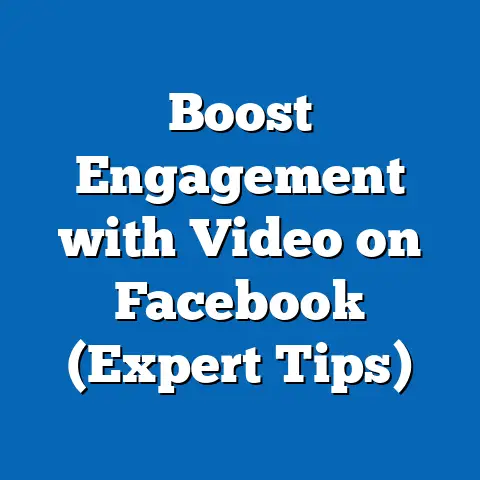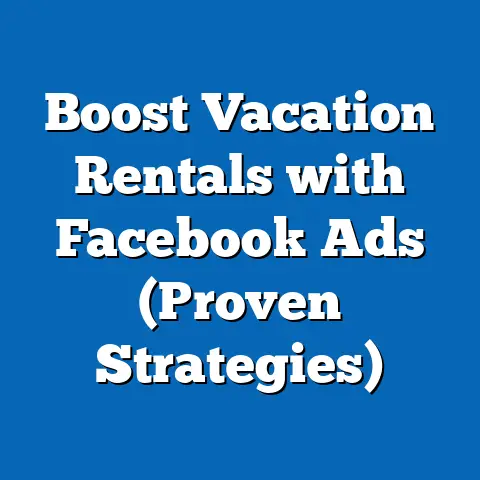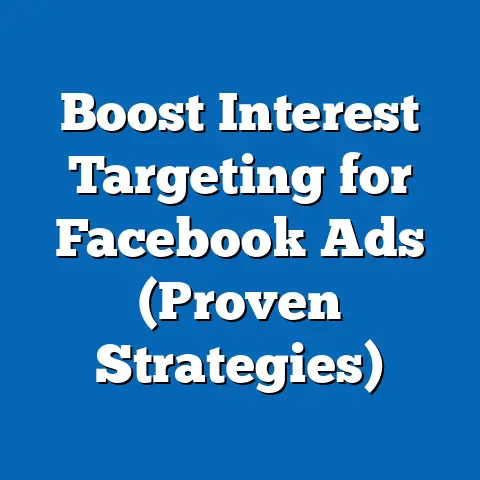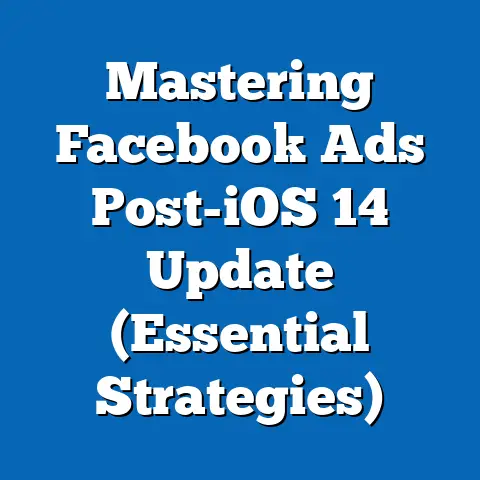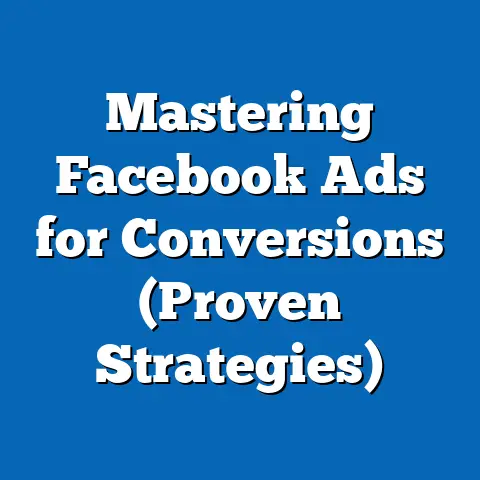Transform Facebook App into Profitable Ads (Expert Guide)
In 2004, when Facebook first emerged as a dorm-room project at Harvard University, it was a simple social networking site with no hint of the advertising juggernaut it would become. By 2007, the platform had introduced its first ad format, “Flyers,” allowing businesses to target users for as little as $5 per day. Fast forward to 2023, and Meta, Facebook’s parent company, reported advertising revenue of $131.9 billion, accounting for 97.8% of its total revenue, according to its annual financial report.
This seismic shift from a college networking tool to a global advertising powerhouse reflects broader trends in digital behavior. As of 2023, Facebook boasts 3.05 billion monthly active users (MAUs) worldwide, per Meta’s Q3 2023 earnings report, making it the largest social media platform by user base. This report analyzes how businesses can transform the Facebook app into a profitable advertising platform, leveraging historical data, demographic insights, and emerging trends to craft effective strategies.
We begin with a historical overview of Facebook’s advertising evolution, followed by a detailed demographic breakdown of its user base, trend analysis of ad performance, and actionable strategies for maximizing return on investment (ROI). Data for this report is sourced from Meta’s public financial disclosures, industry reports like eMarketer, and surveys such as Pew Research Center’s 2023 Social Media Usage study (sample size: 5,733 U.S. adults, conducted January-February 2023).
Section 1: Historical Context of Facebook Advertising
The Early Years: From Flyers to Sponsored Stories
Facebook’s initial foray into advertising with Flyers in 2007 was rudimentary, targeting users based on basic profile information like age and location. By 2009, the platform introduced “Sponsored Stories,” which integrated ads into users’ news feeds, capitalizing on social endorsements. This marked a 300% increase in ad engagement compared to traditional banner ads, according to a 2010 Nielsen study.
Revenue growth was exponential in these formative years. In 2012, Facebook generated $5.1 billion in ad revenue, a figure that surged to $17.4 billion by 2015, representing a 241% increase over three years, per Meta’s historical financial data. The introduction of mobile ads in 2012 was a pivotal moment, as mobile usage overtook desktop by 2014, with 68% of ad revenue coming from mobile devices by 2015.
Modern Era: Precision Targeting and Algorithmic Power
By 2018, Facebook’s ad platform had evolved into a sophisticated ecosystem driven by machine learning and granular targeting options. Advertisers could target users based on interests, behaviors, and even life events, with 91% of businesses reporting improved customer acquisition through Facebook ads, according to a 2019 Hootsuite survey (sample size: 2,500 global marketers). Ad revenue reached $69.7 billion in 2019, a 27% year-over-year increase from 2018.
The COVID-19 pandemic further accelerated digital ad spend, with Facebook’s 2020 revenue climbing to $84.2 billion, a 21% increase from 2019. This growth was fueled by a 12% rise in MAUs to 2.8 billion as people turned to digital platforms during lockdowns, per Meta’s 2020 annual report. Today, innovations like dynamic ads and augmented reality (AR) formats continue to redefine engagement, with AR ads showing a 94% higher click-through rate (CTR) than standard formats in 2022, per Meta’s internal data.
Section 2: Demographic Breakdown of Facebook Users
Understanding Facebook’s user base is critical for tailoring profitable ad campaigns. Below, we break down usage patterns by age, gender, race, and income level using data from Pew Research Center (2023) and Meta’s Q3 2023 user statistics.
Age Distribution
Facebook’s user base skews slightly older compared to platforms like Instagram or TikTok. As of 2023, 69% of U.S. adults aged 18-29 use Facebook, but usage peaks among those aged 30-49 at 76%. For users aged 50-64, 68% are active on the platform, while only 49% of those 65+ engage regularly, per Pew Research.
This distribution reflects a shift from earlier years when younger users dominated. In 2015, 87% of 18-29-year-olds used Facebook, a decline of 18 percentage points by 2023, signaling migration to newer platforms. Advertisers targeting Gen Z (18-24) may need complementary strategies on other apps, while those targeting Millennials (25-44) and Gen X (45-64) can rely heavily on Facebook.
Gender Breakdown
Usage is relatively balanced by gender, with 68% of U.S. women and 65% of U.S. men active on Facebook in 2023, per Pew Research. However, engagement patterns differ: women are 15% more likely to interact with community groups and events, while men show a 10% higher interaction rate with political content, based on Meta’s 2022 engagement metrics.
This suggests gender-specific content strategies can enhance ad performance. For instance, lifestyle and family-oriented ads may resonate more with female audiences, while tech or news-related ads could target male users effectively.
Racial and Ethnic Composition
Facebook’s U.S. user base mirrors national demographics with slight variations. In 2023, 70% of White adults, 67% of Black adults, and 66% of Hispanic adults use the platform, per Pew Research. Engagement among Hispanic users has grown by 8% since 2019, driven by community-building features like Groups, which saw a 14% uptick in usage among this demographic.
Advertisers should note language preferences, as 22% of Hispanic users prefer Spanish-language content, per a 2022 Nielsen report. Culturally relevant campaigns can significantly boost engagement in this growing segment.
Income Levels
Usage correlates with income, though differences are narrowing. In 2023, 72% of U.S. adults earning over $75,000 annually use Facebook, compared to 66% of those earning under $30,000, per Pew Research. Higher-income users are 20% more likely to engage with premium brand ads, while lower-income users show a 25% higher response to discount-driven campaigns, based on Meta’s 2023 ad performance data.
This income disparity highlights the need for tailored messaging. Luxury brands may focus on affluent users with aspirational content, while value-driven businesses can target cost-conscious audiences with promotions.
Section 3: Trend Analysis of Facebook Advertising
Growth in Ad Spend and ROI
Global ad spend on Facebook has risen steadily, reaching $121.9 billion in 2022, a 10% increase from $110.7 billion in 2021, per eMarketer. This growth is driven by small and medium-sized businesses (SMBs), which account for 60% of ad spend, as reported by Meta in 2023. Average ROI for Facebook ads stands at 3.5x, with e-commerce sectors reporting up to 6x returns, per a 2022 WordStream analysis.
However, cost-per-click (CPC) has increased by 17% year-over-year to an average of $0.97 in 2023, reflecting higher competition. Industries like finance and insurance face the highest CPCs at $3.77, while retail averages $0.70, per WordStream data. Advertisers must optimize for cost efficiency through precise targeting and creative testing.
Shift to Video and Interactive Formats
Video ads have become a dominant force, accounting for 54% of total ad impressions on Facebook in 2023, up from 41% in 2020, per Meta’s ad insights. Short-form video, spurred by competition with TikTok, has seen a 62% increase in engagement since the launch of Reels in 2020. Interactive formats like polls and carousel ads also outperform static images, with a 30% higher CTR, per a 2023 Socialbakers report.
This trend underscores the importance of dynamic content. Businesses ignoring video risk falling behind, as 78% of users report watching video content weekly on Facebook, per Pew Research 2023.
Privacy Changes and Targeting Challenges
Apple’s iOS 14.5 update in 2021, introducing App Tracking Transparency (ATT), impacted Facebook’s ad targeting capabilities, with Meta estimating a $10 billion revenue loss in 2022 due to reduced data access. Only 25% of iOS users opted into tracking post-update, per Flurry Analytics. This has forced a pivot to contextual targeting and first-party data, with 64% of advertisers adopting lookalike audiences based on website data, per a 2023 eMarketer survey.
Advertisers must adapt by leveraging Meta’s on-platform tools like Custom Audiences and focusing on organic content to build trust. The decline in personalized ad effectiveness—CTR dropped 15% post-ATT, per AppsFlyer—signals a need for broader, interest-based strategies.
Section 4: Strategies to Transform Facebook into Profitable Ads
1. Leverage Advanced Targeting Tools
Despite privacy constraints, Facebook’s ad platform offers robust targeting options. Custom Audiences, built from email lists or website visitors, achieve a 2x higher conversion rate than interest-based targeting, per Meta’s 2023 data. Lookalike Audiences, mirroring existing customers, deliver a 1.5x higher ROI on average.
Focus on layering demographics with behaviors. For instance, targeting “engaged shoppers” aged 25-44 with a history of online purchases yields a 40% higher CTR compared to broad age targeting, per WordStream 2023.
2. Optimize for Mobile and Video
With 98.5% of Facebook users accessing the platform via mobile devices in 2023 (Meta Q3 report), mobile-first design is non-negotiable. Vertical video ads for Stories and Reels achieve a 23% higher completion rate than horizontal formats, per a 2022 Creative Shop study by Meta. Keep videos under 15 seconds for maximum retention—60% of users drop off after this mark, per Wistia analytics.
Test thumbnail impact, as 85% of video views occur with sound off, per Meta. Strong visuals and captions can boost engagement by 12%, ensuring accessibility across demographics.
3. Utilize A/B Testing for Creative and Copy
A/B testing remains a cornerstone of ad optimization. Testing two ad creatives can improve CTR by 25%, while testing headlines can boost conversions by 19%, per a 2023 AdEspresso study. Allocate 10-15% of the budget to testing phases, rotating variables like images, CTAs, and audience segments over 7-14 days.
Analyze results through Meta’s Ads Manager, focusing on cost-per-acquisition (CPA). Campaigns with iterative testing report a 30% lower CPA over three months, per WordStream data.
4. Capitalize on Seasonal and Event-Based Campaigns
Facebook users increase engagement by 18% during major holidays like Christmas and Black Friday, per Meta’s 2022 holiday insights. SMBs running event-based campaigns see a 2.3x lift in sales compared to non-seasonal periods, per a 2023 Shopify report. Start campaigns 2-3 weeks prior to peak dates, using countdown timers in ads to create urgency.
Target specific demographics during these periods. For example, 55% of women aged 25-54 drive holiday purchases, per Nielsen 2022, making them a prime audience for seasonal ads.
5. Integrate Retargeting for Higher Conversions
Retargeting users who interacted with a brand but didn’t convert is highly effective, with a 70% higher likelihood of purchase compared to cold audiences, per a 2023 Criteo report. Dynamic Product Ads (DPAs) for e-commerce, showcasing previously viewed items, achieve a 3x higher conversion rate, per Meta data. Install the Facebook Pixel to track website activity, ensuring compliance with privacy regulations.
Cap frequency at 3-5 impressions per user to avoid ad fatigue, as overexposure reduces CTR by 40% after the fifth view, per a 2022 Socialbakers study.
Section 5: Case Studies of Successful Campaigns
Case Study 1: E-Commerce Brand Boosts Sales by 400%
A mid-sized U.S. apparel brand targeted women aged 18-34 with carousel ads featuring user-generated content in Q4 2022. Using a $50,000 budget over 60 days, they achieved a 400% increase in sales, with a CPA of $8.50 compared to an industry average of $12.30, per Meta’s case study data. Retargeting cart abandoners contributed 30% of total conversions.
Key takeaway: Authentic visuals and retargeting can significantly lower acquisition costs while scaling revenue, especially for younger demographics.
Case Study 2: Local Service Business Doubles Leads
A plumbing service in the Midwest targeted homeowners aged 35-64 within a 20-mile radius using lead generation ads in 2023. With a $5,000 monthly budget, they doubled lead volume to 120 per month, with a cost-per-lead of $41, 15% below the industry norm, per WordStream benchmarks. Geo-targeting and testimonials in ad copy drove a 28% higher CTR.
Key takeaway: Hyper-local targeting and trust signals like reviews are critical for service-based businesses targeting older, location-specific audiences.
Section 6: Challenges and Mitigation Strategies
Rising Costs and Competition
As CPC rises (17% YoY to $0.97 in 2023), smaller advertisers face barriers. Mitigate this by focusing on niche audiences—micro-targeting reduces CPC by 26% on average, per AdEspresso 2023. Additionally, schedule ads during off-peak hours (e.g., early mornings), which can lower costs by 10-15%, per WordStream.
Ad Fatigue and Declining Organic Reach
Organic reach has declined to 5.2% in 2023 from 7.7% in 2018, per Hootsuite data, pushing reliance on paid ads. Combat fatigue by refreshing creatives every 2-3 weeks, as 50% of users report ignoring repetitive ads after 14 days, per a 2022 Kantar study. Diversify formats, alternating between Stories, Reels, and feed ads to maintain visibility.
Privacy Regulations and Data Limitations
Post-ATT, 62% of advertisers report challenges in measuring campaign effectiveness, per eMarketer 2023. Shift to server-side tracking via Meta’s Conversions API, which preserves 80% of attribution data compared to pixel-only tracking, per Meta’s 2023 guidance. Encourage first-party data collection through lead forms and on-platform interactions to build sustainable audiences.
Section 7: Future Outlook for Facebook Advertising
Looking ahead, Facebook’s ad ecosystem is poised for further evolution. Meta’s investment in AI-driven ad optimization is expected to increase ad relevance scores by 20% by 2025, per a 2023 Forrester forecast. The integration of generative AI for ad creative could reduce production costs by 30%, making advertising accessible to smaller businesses, per eMarketer projections.
Additionally, the metaverse presents untapped potential, with early AR/VR ad formats showing 2.5x higher engagement in pilot tests, per Meta’s 2023 developer conference data. However, adoption remains low, with only 5% of users engaging in metaverse environments, indicating a long-term rather than immediate opportunity.
Demographic shifts will also shape strategies. As Gen Z usage stabilizes (currently 69% of 18-29-year-olds), platforms like Reels will be key to retaining younger audiences, with 40% of this cohort engaging with short-form content daily, per Pew Research 2023. Meanwhile, aging populations (50+) will drive sustained growth, with usage projected to rise by 10% by 2027, per Statista forecasts.
Conclusion
Transforming the Facebook app into a profitable advertising platform requires a deep understanding of its historical evolution, user demographics, and current trends. From its humble beginnings in 2007 to generating $131.9 billion in ad revenue in 2023, Facebook has proven its adaptability and scale. Businesses can capitalize on this by leveraging precise targeting, mobile-first video content, and iterative testing to maximize ROI.
Demographic insights reveal opportunities across age groups, genders, races, and income levels, with tailored strategies yielding higher engagement—whether targeting Millennials with lifestyle content or lower-income users with promotions. Trends like rising CPC (up 17% YoY) and privacy constraints (post-ATT CTR down 15%) present challenges, but solutions like micro-targeting and first-party data collection offer viable paths forward.
By implementing the strategies outlined—advanced targeting, mobile optimization, A/B testing, seasonal campaigns, and retargeting—businesses can navigate competition and capitalize on Facebook’s 3.05 billion MAUs. As the platform evolves with AI and metaverse innovations, staying agile and data-driven will be key to sustained profitability in this dynamic digital landscape.

